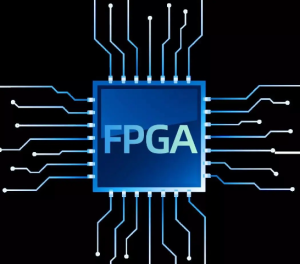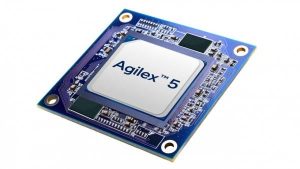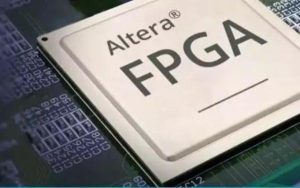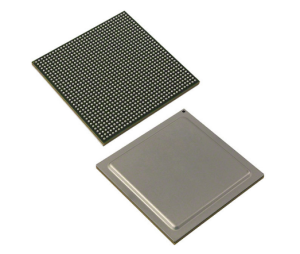“Empower Innovation: Choose the Perfect FPGA for Your Vision”
Johdanto
Selecting the right Field-Programmable Gate Array (FPGA) is a critical decision in the design and development of electronic systems, as it directly impacts performance, flexibility, and overall project success. FPGAs are versatile semiconductor devices that can be programmed to perform a wide range of tasks, from simple logic operations to complex digital signal processing. The selection process involves evaluating various factors such as logic density, I/O capabilities, power consumption, performance requirements, and cost. Additionally, considerations like development tools, vendor support, and future scalability play a significant role. Understanding these parameters and aligning them with the specific needs of the application ensures that the chosen FPGA will meet the desired objectives efficiently and effectively.

Understanding FPGA Specifications: Key Factors to Consider
When selecting the right Field-Programmable Gate Array (FPGA) for a specific application, understanding the various specifications and key factors is crucial. FPGAs are highly versatile and reconfigurable integrated circuits that can be programmed to perform a wide range of tasks, from simple logic operations to complex digital signal processing. To make an informed decision, it is essential to consider several critical aspects that influence the performance, cost, and suitability of the FPGA for the intended application.
One of the primary factors to consider is the logic capacity of the FPGA, which is typically measured in terms of the number of logic elements (LEs) or logic cells. The logic capacity determines the complexity of the digital circuits that can be implemented on the FPGA. For applications requiring extensive computational resources, such as image processing or machine learning, a high logic capacity is essential. Conversely, for simpler tasks, a lower logic capacity may suffice, potentially reducing costs.
In addition to logic capacity, the number of input/output (I/O) pins is another critical specification. The I/O pins facilitate communication between the FPGA and other components in the system, such as sensors, memory, and processors. The required number of I/O pins depends on the application’s connectivity needs. For instance, applications involving multiple peripherals or high-speed data transfer may necessitate a higher number of I/O pins to ensure efficient communication.
Another important consideration is the FPGA’s clock speed, which influences the overall performance and speed of the implemented design. The clock speed, measured in megahertz (MHz) or gigahertz (GHz), determines how fast the FPGA can process data. High-performance applications, such as real-time data processing or high-frequency trading, benefit from FPGAs with higher clock speeds. However, it is also important to consider power consumption, as higher clock speeds can lead to increased power usage and thermal dissipation.
Memory resources within the FPGA are also a key factor to evaluate. FPGAs typically include various types of memory, such as block RAM (BRAM), distributed RAM, and shift registers. The amount and type of memory required depend on the application’s data storage and processing needs. For example, applications involving large datasets or complex algorithms may require substantial BRAM to store intermediate data and results. Additionally, the availability of embedded memory can significantly impact the efficiency and performance of the design.
Furthermore, the FPGA’s power consumption is a critical factor, especially for battery-powered or energy-sensitive applications. Power consumption is influenced by several factors, including logic capacity, clock speed, and the specific design implemented on the FPGA. Low-power FPGAs are designed to minimize energy usage while maintaining adequate performance, making them suitable for portable devices and remote sensing applications.
The development tools and ecosystem provided by the FPGA manufacturer also play a significant role in the selection process. Comprehensive development tools, such as design software, simulation tools, and debugging utilities, facilitate the design and implementation process. Additionally, a robust ecosystem, including reference designs, intellectual property (IP) cores, and community support, can accelerate development and reduce time-to-market.
Lastly, cost considerations cannot be overlooked. The price of an FPGA is influenced by its specifications, such as logic capacity, I/O count, and additional features. Balancing performance requirements with budget constraints is essential to selecting an FPGA that meets the application’s needs without exceeding financial limitations.
In conclusion, selecting the right FPGA involves a careful evaluation of various specifications, including logic capacity, I/O pins, clock speed, memory resources, power consumption, development tools, and cost. By thoroughly understanding these key factors, engineers and designers can make informed decisions that ensure the chosen FPGA aligns with the specific requirements and constraints of their application.
Comparing FPGA Brands: Xilinx vs. Intel
When selecting the right Field-Programmable Gate Array (FPGA) for a project, engineers often find themselves comparing the two leading brands in the market: Xilinx and Intel. Both companies offer a range of FPGA products that cater to various applications, from simple logic implementations to complex system-on-chip (SoC) designs. Understanding the differences between these brands can help in making an informed decision.

Xilinx, now a part of AMD, has long been a dominant player in the FPGA market. Known for its high-performance devices, Xilinx offers a broad portfolio that includes the Spartan, Artix, Kintex, and Virtex families. These product lines cater to different performance and cost requirements, making Xilinx a versatile choice for many applications. For instance, the Spartan series is designed for cost-sensitive applications, while the Virtex series targets high-performance computing and advanced signal processing.
On the other hand, Intel, which acquired Altera in 2015, has also established itself as a formidable competitor in the FPGA space. Intel’s FPGA offerings include the Cyclone, Arria, and Stratix families. Similar to Xilinx, Intel’s product lines are tailored to meet various performance and cost needs. The Cyclone series is aimed at low-cost, low-power applications, whereas the Stratix series is intended for high-end, high-performance applications.
One of the key factors to consider when comparing Xilinx and Intel FPGAs is the architecture. Xilinx FPGAs are known for their advanced architecture, which includes features like UltraScale and UltraScale+ technologies. These architectures provide high logic density, improved power efficiency, and enhanced performance. Intel FPGAs, on the other hand, leverage HyperFlex architecture, which offers unique features such as Hyper-Registers that enable higher performance and lower power consumption.
Another important aspect to consider is the development tools and software support. Xilinx provides the Vivado Design Suite, which is a comprehensive toolset for FPGA design and implementation. Vivado offers advanced features like High-Level Synthesis (HLS), which allows designers to use high-level programming languages like C and C++ to develop FPGA applications. Intel offers the Quartus Prime software, which is also a robust toolset for FPGA design. Quartus Prime includes features like Platform Designer and HLS, providing a similar level of support for high-level programming.
In terms of ecosystem and community support, both Xilinx and Intel have extensive resources available for developers. Xilinx has a well-established community and a wealth of documentation, tutorials, and reference designs. Intel also offers a strong support network, with comprehensive documentation and a range of development kits and reference designs.
When it comes to performance benchmarks, both Xilinx and Intel FPGAs have their strengths. Xilinx devices are often praised for their high-speed transceivers and DSP capabilities, making them ideal for applications like wireless communication and video processing. Intel FPGAs, with their HyperFlex architecture, excel in applications that require high throughput and low latency, such as data centers and high-frequency trading.
Ultimately, the choice between Xilinx and Intel FPGAs depends on the specific requirements of the project. Factors such as performance, power consumption, cost, and development tools should all be considered. By carefully evaluating these aspects, engineers can select the FPGA that best meets their needs, ensuring the success of their design.
Budgeting for Your FPGA Project: Cost vs. Performance
When embarking on an FPGA project, one of the most critical considerations is budgeting, which involves a delicate balance between cost and performance. FPGAs, or Field-Programmable Gate Arrays, offer unparalleled flexibility and performance for a wide range of applications, from simple logic implementations to complex system-on-chip designs. However, the cost associated with these devices can vary significantly, making it essential to carefully evaluate your project’s requirements and constraints.
To begin with, understanding the specific needs of your project is paramount. This involves identifying the computational requirements, the complexity of the design, and the expected performance metrics. For instance, a project requiring high-speed data processing and extensive parallelism will necessitate a more powerful and, consequently, more expensive FPGA. Conversely, simpler projects with modest performance requirements can often be accomplished with lower-cost devices. Therefore, a thorough analysis of the project’s technical specifications is the first step in making an informed decision.
Once the technical requirements are clear, the next step is to explore the available FPGA options within your budget. FPGAs come in various families and models, each offering different levels of performance, logic resources, and I/O capabilities. Leading manufacturers such as Xilinx and Intel provide a broad spectrum of devices, ranging from low-cost, low-power options to high-end, high-performance models. It is crucial to compare these options not only in terms of their initial purchase price but also considering the total cost of ownership, which includes factors such as development tools, intellectual property (IP) cores, and potential future upgrades.
In addition to the hardware costs, the development environment and associated tools play a significant role in the overall budget. High-end FPGAs often require sophisticated development tools and software licenses, which can add to the project’s expenses. However, these tools can also enhance productivity and reduce development time, potentially offsetting their cost. Evaluating the trade-offs between tool costs and development efficiency is essential for optimizing the budget.
Moreover, considering the scalability and future-proofing of your FPGA choice is vital. While it may be tempting to select a lower-cost FPGA to meet immediate budget constraints, this decision could limit the project’s ability to scale or adapt to future requirements. Investing in a slightly more expensive FPGA with additional resources and capabilities can provide a buffer for unforeseen changes and expansions, ultimately offering better value in the long run.
Another important aspect to consider is the availability of support and documentation. High-performance FPGAs often come with extensive support from the manufacturer, including detailed documentation, reference designs, and technical support. This can significantly reduce development time and mitigate risks associated with complex designs. While lower-cost FPGAs may offer fewer support resources, they can still be a viable option for projects with well-defined and less demanding requirements.
In conclusion, budgeting for an FPGA project requires a careful assessment of both cost and performance. By thoroughly understanding the project’s technical needs, comparing available FPGA options, evaluating development tools, considering scalability, and factoring in support resources, you can make an informed decision that balances cost with performance. This strategic approach ensures that your FPGA project remains within budget while achieving the desired performance outcomes, ultimately leading to a successful and efficient implementation.
Evaluating FPGA Development Tools and Software
When selecting the right Field-Programmable Gate Array (FPGA) for your project, evaluating the available development tools and software is a critical step. The choice of tools can significantly impact the efficiency of your design process, the performance of your final product, and the ease with which you can implement and test your designs. Therefore, it is essential to consider several factors when assessing FPGA development tools and software.

Firstly, the compatibility of the development tools with your chosen FPGA is paramount. Different FPGA manufacturers provide proprietary software tailored to their hardware. For instance, Xilinx offers the Vivado Design Suite, while Intel provides the Quartus Prime software. These tools are optimized for their respective FPGAs, offering features that leverage the unique capabilities of their hardware. Consequently, selecting a development tool that aligns with your FPGA ensures seamless integration and maximizes the potential of your design.
Moreover, the user interface and ease of use of the development software play a significant role in the design process. A user-friendly interface can reduce the learning curve, allowing designers to focus more on the creative aspects of their projects rather than grappling with complex software. Tools that offer intuitive graphical interfaces, comprehensive documentation, and robust support communities can greatly enhance productivity. For example, Vivado’s graphical user interface (GUI) is known for its ease of navigation and extensive online resources, which can be invaluable for both novice and experienced designers.
In addition to ease of use, the functionality and features provided by the development tools are crucial. Advanced features such as high-level synthesis (HLS), which allows designers to use high-level programming languages like C or C++ to describe hardware functionality, can significantly speed up the design process. Furthermore, tools that offer powerful debugging and simulation capabilities enable designers to identify and rectify issues early in the development cycle, thereby reducing time-to-market. For instance, Quartus Prime includes sophisticated simulation tools that allow for thorough testing and validation of designs before deployment.
Another important consideration is the availability of intellectual property (IP) cores and libraries. IP cores are pre-designed and pre-verified blocks of logic that can be integrated into your FPGA design, saving time and effort. Development tools that provide access to a wide range of IP cores can simplify the design process and enhance the functionality of your final product. Both Vivado and Quartus Prime offer extensive IP libraries, covering a broad spectrum of applications from simple arithmetic operations to complex communication protocols.
Furthermore, the scalability and flexibility of the development tools should not be overlooked. As projects grow in complexity, the ability to scale your design and adapt to new requirements becomes increasingly important. Tools that support modular design approaches and offer flexible licensing options can accommodate evolving project needs. This flexibility ensures that your development environment can grow alongside your project, providing long-term value.
Lastly, the cost of the development tools and software is a practical consideration. While some tools are available for free or at a low cost, others may require significant investment. It is essential to weigh the cost against the benefits provided by the tools, considering factors such as the potential for reduced development time, improved performance, and enhanced design capabilities. In some cases, investing in premium tools may be justified by the long-term gains in efficiency and product quality.
In conclusion, evaluating FPGA development tools and software involves a comprehensive assessment of compatibility, ease of use, functionality, IP core availability, scalability, flexibility, and cost. By carefully considering these factors, designers can select the tools that best meet their needs, ultimately leading to more efficient development processes and superior final products.
Future-Proofing Your FPGA Selection: Scalability and Upgradability
When selecting a Field-Programmable Gate Array (FPGA) for your project, it is crucial to consider not only the immediate requirements but also the long-term implications of your choice. Future-proofing your FPGA selection involves evaluating the scalability and upgradability of the device to ensure it can adapt to evolving technological demands and project needs. This approach can save significant time and resources in the long run, making it a vital aspect of the decision-making process.
To begin with, scalability is a key factor in future-proofing your FPGA selection. Scalability refers to the ability of the FPGA to handle increasing workloads or to be expanded with additional resources as needed. When assessing scalability, one should consider the logic elements, memory blocks, and input/output (I/O) capabilities of the FPGA. A device with a higher number of logic elements and memory blocks can accommodate more complex designs and larger data sets, which is essential for projects that may grow in scope over time. Additionally, ample I/O capabilities ensure that the FPGA can interface with a variety of peripherals and external devices, providing flexibility for future expansions.
Moreover, the architecture of the FPGA plays a significant role in its scalability. Modern FPGAs often feature a modular architecture, allowing designers to add or remove functional blocks as required. This modularity enables the FPGA to be tailored to specific applications while retaining the ability to scale up or down based on future needs. For instance, some FPGAs support partial reconfiguration, which allows certain sections of the FPGA to be reprogrammed without affecting the entire device. This feature is particularly useful for applications that require frequent updates or modifications, as it minimizes downtime and enhances overall system efficiency.

In addition to scalability, upgradability is another critical aspect to consider when future-proofing your FPGA selection. Upgradability refers to the ease with which the FPGA can be updated or enhanced with new features and capabilities. One way to ensure upgradability is to choose an FPGA from a vendor with a strong track record of providing regular updates and support. This includes firmware updates, development tools, and intellectual property (IP) cores that can be integrated into your design. A robust ecosystem of tools and support can significantly extend the lifespan of your FPGA, allowing it to keep pace with technological advancements.
Furthermore, compatibility with industry standards and protocols is essential for upgradability. An FPGA that supports widely adopted standards, such as PCIe, Ethernet, or DDR memory interfaces, can more easily integrate with new technologies and systems as they emerge. This compatibility ensures that your FPGA-based design remains relevant and can be seamlessly upgraded with minimal effort.
Another important consideration is the availability of development resources and community support. FPGAs with a large user base and active community often benefit from a wealth of shared knowledge, tutorials, and third-party tools. This collective expertise can be invaluable when troubleshooting issues or seeking advice on optimizing your design for future requirements. Additionally, open-source resources and forums can provide insights into best practices and innovative solutions that can enhance the upgradability of your FPGA.
In conclusion, future-proofing your FPGA selection by focusing on scalability and upgradability is essential for ensuring the longevity and adaptability of your project. By carefully evaluating the logic elements, memory blocks, I/O capabilities, architecture, vendor support, industry standards compatibility, and available development resources, you can select an FPGA that not only meets your current needs but also has the potential to grow and evolve with your project. This strategic approach will help you maximize the return on your investment and maintain a competitive edge in an ever-changing technological landscape.
KYSYMYKSET JA VASTAUKSET
1. **Q:** What is the primary factor to consider when selecting an FPGA?
**A:** The primary factor is the required logic resources, such as the number of logic elements or lookup tables (LUTs).
2. **Q:** How does power consumption influence FPGA selection?
**A:** Power consumption is crucial for battery-operated or energy-sensitive applications, necessitating the choice of low-power FPGAs.
3. **Q:** Why is I/O pin count important in FPGA selection?
**A:** The I/O pin count determines the FPGA’s ability to interface with other components and peripherals in the system.
4. **Q:** What role does the FPGA’s clock speed play in the selection process?
**A:** Clock speed affects the performance and throughput of the FPGA, making it essential for high-speed applications.
5. **Q:** How does the availability of development tools and support impact FPGA selection?
**A:** Comprehensive development tools and strong vendor support can significantly ease the design process and reduce time-to-market.
Päätelmä
Selecting the right FPGA involves evaluating key factors such as performance requirements, power consumption, cost, available development tools, and support for necessary interfaces and protocols. It is crucial to consider the specific application needs, including processing speed, logic density, and I/O capabilities. Additionally, assessing the vendor’s ecosystem, including software support, documentation, and community resources, can significantly impact the development process. Ultimately, the right FPGA should balance these factors to meet the project’s technical and budgetary constraints while ensuring scalability and future-proofing.
